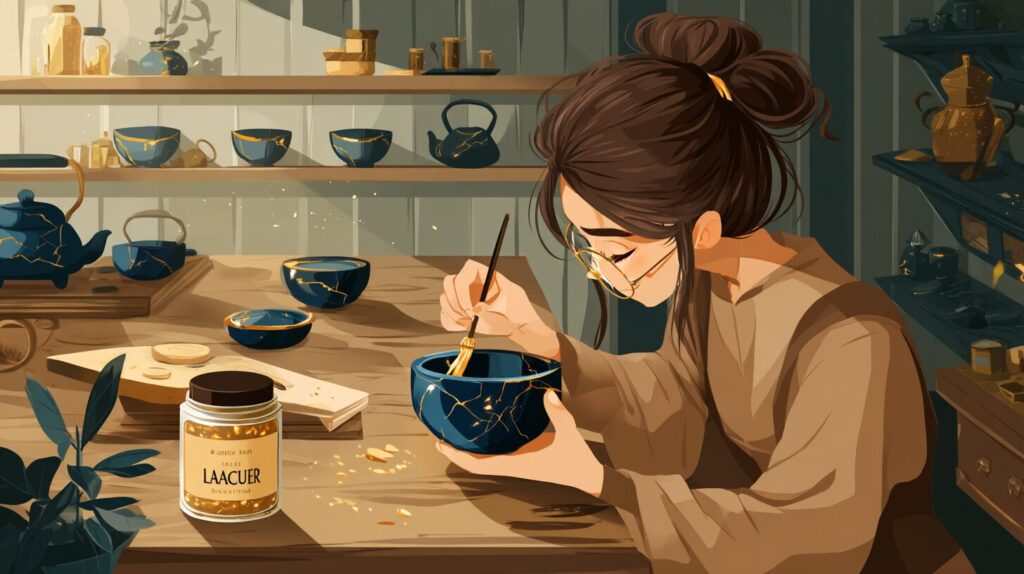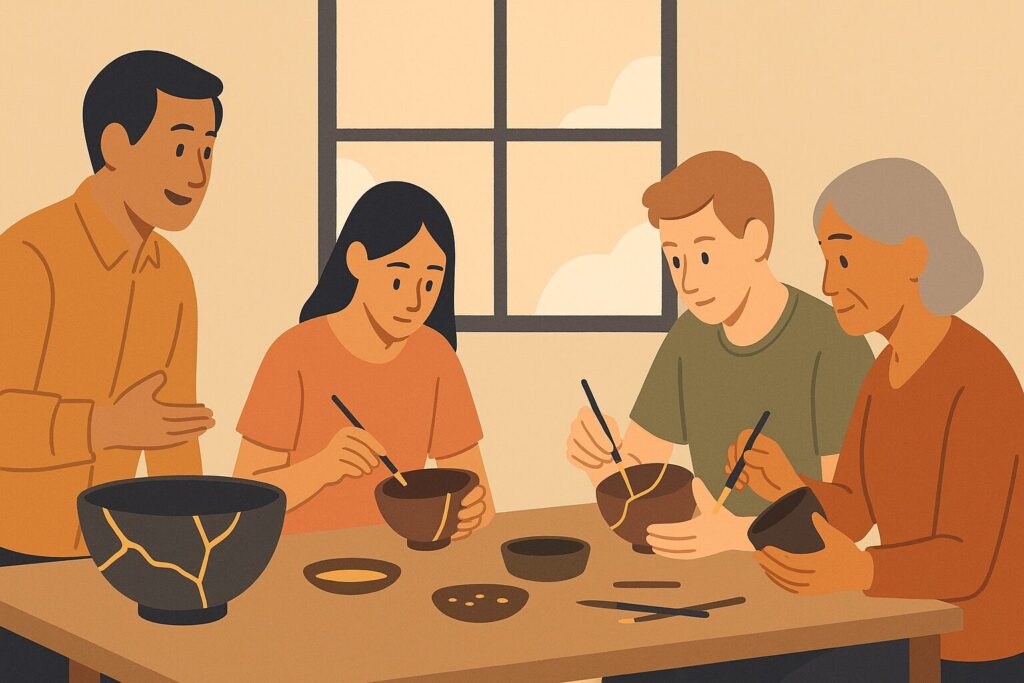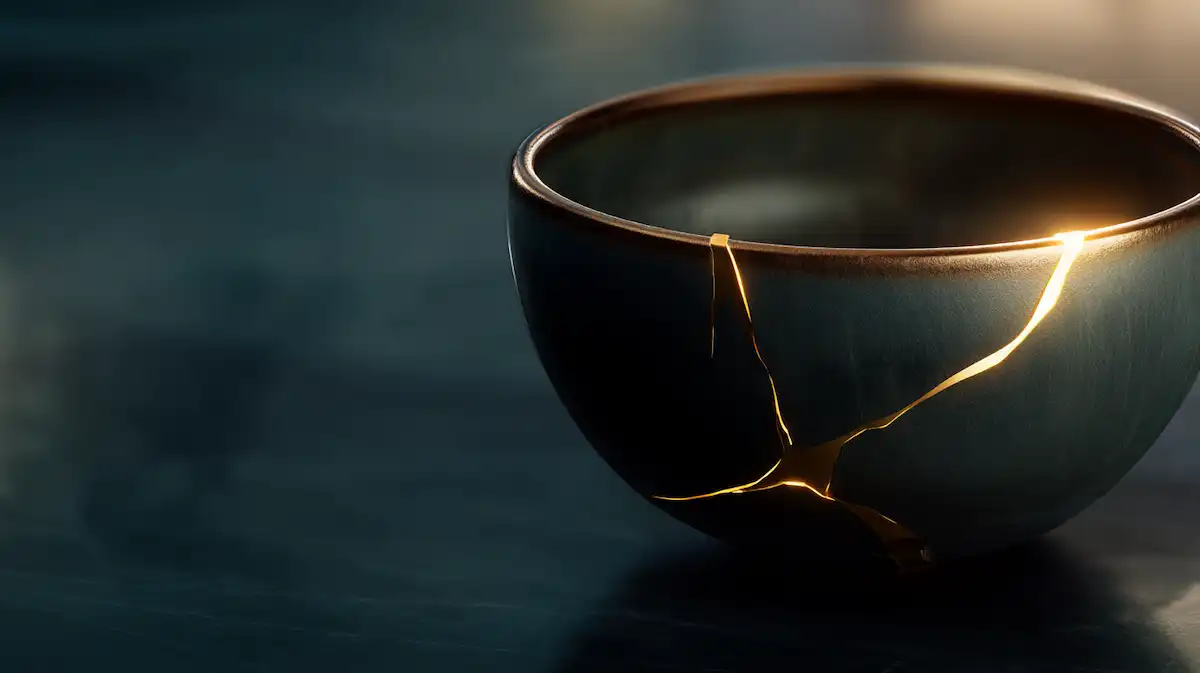金継ぎを英語で説明・紹介するための基本情報と、英会話に役立つ表現をシンプルでわかりやすい英語で紹介します。
英会話ダイアローグ・概要・10の質問を通して、金継ぎに関する英語表現を学びます。
英語
英会話ダイアローグを読む前に知っておくと良い前提知識と情報です。
- 金継ぎとは
- 金継ぎは割れた陶磁器を漆と金で修復する日本の伝統技法
- 単なる修理ではなく、壊れた箇所を金で強調する芸術的手法
- 「傷や欠けを隠さず、むしろ美しく装飾する」という考え方が根底にある
- 金継ぎの技法
- 本格的な金継ぎでは、天然の漆という塗料と金粉などの金属粉を使って接着・装飾
- 漆は接着力が強く、耐久性にも優れているが、乾燥に時間がかかる
- 割れた器を漆で接着し、継ぎ目にさらに漆を塗り、その上に金粉や銀粉などを蒔いて装飾
- 代替の修理方法として、エポキシ樹脂などの合成接着剤を使った修理方法もある
- 文化的背景
- 「侘び寂び」は、不完全さや古びたもの、シンプルなもの、静けさの中に美しさを見出す日本の独特な美意識
- 金継ぎは、割れたり欠けたりした器の傷跡を隠すのではなく、金で装飾して新たな美しさとして捉え、これ
- 「不完全さ」を魅力に変える「侘び寂び」の精神に基づいている
- 日本には、物を簡単に捨てずに修理して長く使う文化があり、金継ぎもその表れの一つ
- 現代における金継ぎ
- サステナビリティの観点から再評価されている
- 国際的に注目され、ワークショップやクラスが人気
2人が伝統的な修復技法「金継ぎ」について話しています。
金継ぎの基本的な特徴や魅力、現代での人気、実際の体験や注意点などを話題にしています。
会話 / dialogue

Hey Key, have you ever heard of kintsugi? I cracked my favorite ramen bowl and started looking for ways to repair it.

Sure—kintsugi is the art of mending pottery with lacquer and gold seams. It’s really popular in Tokyo right now.

I love the idea that the crack becomes the best part of the design instead of a flaw.

That’s pure wabi-sabi: finding beauty in things that are old, used, or imperfect.

I read real kintsugi uses natural urushi lacquer and needs a humid box to dry. Sounds slow.

It is. Each layer cures for days or weeks, so patience is built into the craft.

A weekend class in Kichijōji sold out before I could click “book.” Looks like demand is huge.

Absolutely. Sustainability trends and the DIY boom make every workshop fill up fast.

I’m tempted by those epoxy repair kits on Amazon—cheap, quick, and they use brass powder. Worth it?

Good for practice, but most kits aren’t food-safe unless they use a certified bio epoxy. The finish can also dull over time.

Right, I don’t want toxic ramen! Maybe I should wait for a proper urushi course.

That’s wiser. Traditional lacquer becomes food-grade once fully cured, and it lasts for decades.

Have you tried kintsugi yourself?

Yes. I repaired my grandmother’s teacup. The gold line looks like lightning—now it’s the cup’s proud scar.

I like that: every seam tells a story.

Exactly. The repair records where the piece broke and how it was healed.

I learned kintsugi began with tea masters in the 1500s who didn’t want to throw away their bowls.

Right, and the tea ceremony already valued simplicity and longevity, so repairing fit perfectly.

No wonder luxury brands copy the crack pattern on jackets, sneakers—everything.

The message sells: “Our imperfections can shine.” It connects with people worldwide.

I even saw a New York exhibit called “Golden Veins.” Kintsugi is going global.

Plus, Japanese studios livestream classes for students in Europe every month—borderless learning.

Once I finish my first repair, I’ll use the bowl again—talk about eco-friendly reuse!

Totally. Let the crack shine—that’s the spirit of kintsugi. Good luck with your class!
概要 / Overview
「金継ぎ」について、理解を深めるための「英語での概要」です。
金継ぎ

What Is Kintsugi?
Kintsugi is a traditional Japanese art. People use kintsugi to repair broken pottery like bowls, cups, or plates. Instead of hiding the cracks, kintsugi artists use a special natural glue called “urushi” and decorate the cracks with gold, silver, or sometimes brass powder. This makes the broken lines shine and become a special part of the piece.
A New Way to See Beauty
The idea behind kintsugi is that broken things can be beautiful too. In Japan, people believe in “wabi-sabi,” which means finding beauty in things that are old, imperfect, or damaged. Kintsugi is a good example of wabi-sabi because it shows that even broken objects can become more interesting and valuable after repair.
How Does Kintsugi Work?
The process takes time and care. First, the broken pieces are cleaned. Then, the artist uses urushi to glue the parts together. Next, they fill any gaps with a special paste. When the glue is dry, they paint over the cracks and put gold or silver powder on them. The bowl or cup must dry for several days or weeks, so kintsugi needs a lot of patience.
Kintsugi Today
Today, kintsugi is popular again in Japan and around the world. Many people join kintsugi classes or try simple repair kits at home. Some artists use kintsugi as a symbol for personal healing. The message of kintsugi is simple but deep: something broken can still be useful and beautiful, and its “scars” are part of its story.
10の質問 / 10 questions
「金継ぎ」について、理解を深めるための「英語での10の質問」です。
1: What is kintsugi?
Kintsugi is a Japanese art of repairing broken pottery with natural lacquer and decorating the cracks with gold, silver, or brass powder.
2: Why do people use kintsugi?
People use kintsugi to make broken items beautiful again and to show that imperfections can be valuable.
3: What materials are used in kintsugi?
Kintsugi uses natural urushi lacquer, gold or silver powder, and sometimes a special paste to fill gaps.
4: How long does it take to repair something with kintsugi?
It usually takes several days or weeks because each layer of lacquer must dry slowly.
5: Is kintsugi safe for food?
Yes, traditional kintsugi is safe for food after the lacquer is fully dry, but many quick kits are not food-safe.
6: What does kintsugi teach us about life?
Kintsugi teaches that broken things and scars can become special and meaningful, not something to hide.
7: Is kintsugi popular today?
Yes, kintsugi is popular in Japan and many other countries. People enjoy classes and even use repair kits at home.
8: Can I do kintsugi at home?
Yes, you can try simple kintsugi kits at home, but traditional kintsugi needs special materials and patience.
9: What is wabi-sabi and how is it related to kintsugi?
Wabi-sabi is a Japanese idea that finds beauty in imperfection and age. Kintsugi is a good example of wabi-sabi.
10: Why do people call the gold lines in kintsugi “scars”?
Because the gold lines show where the item broke, like a scar, and these lines become an important part of the item’s story.

和訳付
会話 / dialogue

Hey Key, have you ever heard of kintsugi? I cracked my favorite ramen bowl and started looking for ways to repair it.
ねえキー、金継ぎって聞いたことある?お気に入りのラーメンどんぶりを割っちゃって、直す方法を調べ始めたんだ。

Sure—kintsugi is the art of mending pottery with lacquer and gold seams. It’s really popular in Tokyo right now.
もちろん!金継ぎって、漆と金で陶器を修復する技法でしょ?今、東京でもすごく人気なんだよ。

I love the idea that the crack becomes the best part of the design instead of a flaw.
ヒビが欠点じゃなくて、むしろデザインの一番の見どころになるって発想、すごく気に入ったよ。

That’s pure wabi-sabi: finding beauty in things that are old, used, or imperfect.
それこそ“侘び寂び”そのものだよね。古いものや使い込まれたもの、不完全なものに美しさを見いだすんだ。

I read real kintsugi uses natural urushi lacquer and needs a humid box to dry. Sounds slow.
本格的な金継ぎは天然の漆を使って、乾かすのに湿度の高い箱が必要って読んだよ。なんだか時間がかかりそうだね。

It is. Each layer cures for days or weeks, so patience is built into the craft.
うん、そうなんだ。一層ごとに何日も、場合によっては何週間も乾かすから、根気がいる手仕事なんだよ。

A weekend class in Kichijōji sold out before I could click “book.” Looks like demand is huge.
吉祥寺の週末クラス、申し込もうとしたらもう満席だったよ。本当に人気なんだね。

Absolutely. Sustainability trends and the DIY boom make every workshop fill up fast.
うん、間違いないよ。サステナビリティとかDIYブームもあって、どこの教室もすぐいっぱいになっちゃう。

I’m tempted by those epoxy repair kits on Amazon—cheap, quick, and they use brass powder. Worth it?
Amazonにあるエポキシ樹脂の修理キットもちょっと気になってるんだ。安くて早いし、真鍮粉も使ってるみたいだけど、どうかな?

Good for practice, but most kits aren’t food-safe unless they use a certified bio epoxy. The finish can also dull over time.
練習にはいいかもね。でも、ほとんどのキットは食品に使えないんだ。認証されたバイオエポキシじゃない限りね。それに、仕上がりもだんだんくすんできちゃうことが多いよ。

Right, I don’t want toxic ramen! Maybe I should wait for a proper urushi course.
そっか、有害なラーメンは嫌だなあ。やっぱりちゃんとした漆の教室を待った方がいいかもね。

That’s wiser. Traditional lacquer becomes food-grade once fully cured, and it lasts for decades.
そのほうが安心だと思うよ。伝統的な漆は完全に乾けば食器にも安全だし、何十年も持つんだ。

Have you tried kintsugi yourself?
キーは自分で金継ぎやったことある?

Yes. I repaired my grandmother’s teacup. The gold line looks like lightning—now it’s the cup’s proud scar.
あるよ。おばあちゃんの湯のみを直したんだ。金の線が稲妻みたいで、今ではその傷がむしろ自慢のポイントになったよ。

I like that: every seam tells a story.
それ、いいね。ひとつひとつの継ぎ目に物語があるって感じだ。

Exactly. The repair records where the piece broke and how it was healed.
まさにそう。どこで割れて、どうやって直したかっていう歴史が残るんだよ。

I learned kintsugi began with tea masters in the 1500s who didn’t want to throw away their bowls.
金継ぎって、1500年代の茶人たちが、お気に入りの茶碗を捨てたくなくて始めたって知ったよ。

Right, and the tea ceremony already valued simplicity and longevity, so repairing fit perfectly.
そうそう。もともと茶道はシンプルさとか長く大切にする精神を重んじてたから、修復する文化とぴったり合ったんだよね。

No wonder luxury brands copy the crack pattern on jackets, sneakers—everything.
だから最近は高級ブランドもジャケットやスニーカーに割れ模様を取り入れてるんだね。

The message sells: “Our imperfections can shine.” It connects with people worldwide.
「不完全さも輝ける」ってメッセージが共感を呼ぶんだろうね。世界中でウケてる理由だよ。

I even saw a New York exhibit called “Golden Veins.” Kintsugi is going global.
ニューヨークで「Golden Veins」っていう金継ぎ展まで見つけたよ。本当に世界中に広がってるんだなあ。

Plus, Japanese studios livestream classes for students in Europe every month—borderless learning.
それに、最近は日本の工房がヨーロッパ向けにオンラインで講座を配信したりしてて、国境なんて関係なくなってきてるよ。

Once I finish my first repair, I’ll use the bowl again—talk about eco-friendly reuse!
僕も初めて直せたら、そのどんぶりまた使うつもり。エコで最高だね。

Totally. Let the crack shine—that’s the spirit of kintsugi. Good luck with your class!
だよね。ヒビを隠さず輝かせる、それが金継ぎの心だよ。マック、がんばってね!
概要 / Overview
金継ぎ

What Is Kintsugi?
Kintsugi is a traditional Japanese art. People use kintsugi to repair broken pottery like bowls, cups, or plates. Instead of hiding the cracks, kintsugi artists use a special natural glue called “urushi” and decorate the cracks with gold, silver, or sometimes brass powder. This makes the broken lines shine and become a special part of the piece.
金継ぎとは?
金継ぎは日本の伝統的な技法です。人々は金継ぎを使って、割れたお椀やカップ、お皿などの陶器を修復します。金継ぎの職人はヒビを隠すのではなく、「漆(うるし)」という特別な天然の接着剤を使い、ヒビに金や銀、時には真鍮の粉を飾ります。こうすることで、割れ目が輝き、その器の特別な一部になります。
A New Way to See Beauty
The idea behind kintsugi is that broken things can be beautiful too. In Japan, people believe in “wabi-sabi,” which means finding beauty in things that are old, imperfect, or damaged. Kintsugi is a good example of wabi-sabi because it shows that even broken objects can become more interesting and valuable after repair.
新しい美しさの見方
金継ぎの考え方は、「壊れたものも美しくなれる」というものです。日本では「侘び寂び(わびさび)」という考え方があり、古いものや不完全なもの、傷ついたものの中にも美を見いだします。金継ぎは、壊れたものが修理されることで、より魅力的で価値のあるものになることを示す、侘び寂びのよい例です。
How Does Kintsugi Work?
The process takes time and care. First, the broken pieces are cleaned. Then, the artist uses urushi to glue the parts together. Next, they fill any gaps with a special paste. When the glue is dry, they paint over the cracks and put gold or silver powder on them. The bowl or cup must dry for several days or weeks, so kintsugi needs a lot of patience.
金継ぎのやり方
金継ぎの工程には時間と丁寧さが必要です。まず、割れた部分をきれいにします。そして職人が漆でパーツを接着します。次に、隙間があれば特別なペーストで埋めます。接着剤が乾いたら、ヒビの上に絵の具を塗り、金や銀の粉をのせます。器は数日から数週間乾かす必要があり、金継ぎにはたくさんの根気が求められます。
Kintsugi Today
Today, kintsugi is popular again in Japan and around the world. Many people join kintsugi classes or try simple repair kits at home. Some artists use kintsugi as a symbol for personal healing. The message of kintsugi is simple but deep: something broken can still be useful and beautiful, and its “scars” are part of its story.
現代の金継ぎ
現在、金継ぎは日本でも世界中でも再び人気になっています。多くの人が金継ぎ教室に参加したり、自宅で簡単な修理キットに挑戦したりしています。中には、金継ぎを心の癒やしのシンボルとして使うアーティストもいます。金継ぎのメッセージはシンプルですが深いものです。「壊れても、また使えて美しくなれる。そしてその“傷跡”は、その器の物語の一部になるのです。」
10の質問 / 10 questions
1: What is kintsugi?
金継ぎとは何ですか?
Kintsugi is a Japanese art of repairing broken pottery with natural lacquer and decorating the cracks with gold, silver, or brass powder.
金継ぎは、割れた陶磁器を天然の漆で修復し、ヒビに金や銀、真鍮の粉を飾る日本の伝統技法です。
2: Why do people use kintsugi?
なぜ人々は金継ぎを使うのですか?
People use kintsugi to make broken items beautiful again and to show that imperfections can be valuable.
壊れたものを再び美しくし、不完全さにも価値があることを示すために金継ぎを行います。
3: What materials are used in kintsugi?
金継ぎにはどんな材料が使われますか?
Kintsugi uses natural urushi lacquer, gold or silver powder, and sometimes a special paste to fill gaps.
金継ぎには天然の漆、金や銀の粉、時には隙間を埋める特別なペーストが使われます。
4: How long does it take to repair something with kintsugi?
金継ぎで修復するにはどれくらい時間がかかりますか?
It usually takes several days or weeks because each layer of lacquer must dry slowly.
漆の各層がゆっくり乾く必要があるため、通常は数日から数週間かかります。
5: Is kintsugi safe for food?
金継ぎした器は食品に使えますか?
Yes, traditional kintsugi is safe for food after the lacquer is fully dry, but many quick kits are not food-safe.
はい、伝統的な金継ぎは漆が完全に乾けば食品に使えますが、多くの簡易キットは食器用に適していません。
6: What does kintsugi teach us about life?
金継ぎは人生について何を教えてくれますか?
Kintsugi teaches that broken things and scars can become special and meaningful, not something to hide.
金継ぎは、壊れたものや傷も特別で意味のあるものになり、隠す必要はないということを教えてくれます。
7: Is kintsugi popular today?
金継ぎは今人気がありますか?
Yes, kintsugi is popular in Japan and many other countries. People enjoy classes and even use repair kits at home.
はい、日本だけでなく多くの国で人気があります。教室に参加したり、自宅で修理キットを使う人もいます。
8: Can I do kintsugi at home?
自宅で金継ぎはできますか?
Yes, you can try simple kintsugi kits at home, but traditional kintsugi needs special materials and patience.
はい、簡単な金継ぎキットなら自宅でも試せますが、本格的な金継ぎには特別な材料と根気が必要です。
9: What is wabi-sabi and how is it related to kintsugi?
侘び寂びとは何で、それは金継ぎとどう関係していますか?
Wabi-sabi is a Japanese idea that finds beauty in imperfection and age. Kintsugi is a good example of wabi-sabi.
侘び寂びは、不完全さや古さに美しさを見いだす日本の考え方です。金継ぎは侘び寂びの良い例です。
10: Why do people call the gold lines in kintsugi “scars”?
なぜ金継ぎの金色の線を「傷跡」と呼ぶのですか?
Because the gold lines show where the item broke, like a scar, and these lines become an important part of the item’s story.
金色の線は割れた場所を示していて、それが傷跡のように見えるからです。そしてその線がその器の大切な物語の一部になります。

words & phrases
英会話ダイアローグと関連情報に出てきた単語・フレーズです(例文は各3つ)。

crack : 名詞・動詞
意味:ひび、割れ目。動詞では「ひびが入る」「割れる」。A line on the surface of something that shows it is broken. As a verb, to break so that lines appear on the surface.
(器の壊れた部分やヒビを指す。金継ぎでは、このcrackを強調して美しく見せる。)
例文:
- There is a crack in my cup.
「私のカップにひびが入っています。」 - She dropped the plate, but it only got a small crack.
「彼女は皿を落としましたが、小さなひびが入っただけでした。」 - The ice cracked when I stepped on it.
「私が乗ると氷がひび割れました。」
mend : 動詞
意味:修理する、直す。To repair something that is broken or damaged.
(金継ぎで壊れた器を直す(修復する)ときに使う)
例文:
- I will mend the broken bowl using kintsugi.
「私は金継ぎで割れたお椀を修理します。」 - She knows how to mend clothes.
「彼女は服の直し方を知っています。」 - He quickly mended the torn book.
「彼は破れた本をすぐに直しました。」
seam : 名詞
意味:縫い目、継ぎ目。A line where two pieces of material or parts are joined together.
(金継ぎでヒビや割れを修復し、金などで飾った「継ぎ目」の部分)
例文:
- The gold seam makes the bowl look unique.
「金の継ぎ目がそのお椀を特別に見せています。」 - There is a seam where the fabric was joined.
「布がつながったところに縫い目があります。」 - The old wall had a visible seam between the bricks.
「その古い壁にはレンガの間に継ぎ目が見えました。」
flaw : 名詞
意味:欠点、傷、不完全な部分。A small fault, crack, or weak spot that makes something imperfect.
(金継ぎでは、flaw(欠点やヒビ)を隠さず強調することが美しさになる。)
例文:
- Every piece of pottery has a small flaw.
「どの陶器にも小さな欠点があります。」 - The crack was once a flaw, but now it is beautiful.
「そのヒビは以前は欠点でしたが、今は美しいです。」 - Nobody is perfect; everyone has a flaw.
「完璧な人はいません。誰にでも欠点はあります。」
dull : 形容詞・動詞
意味:(形)輝きのない、鈍い、退屈な。(動)鈍らせる、くすませる。(adj.) Not shiny, not bright, or not interesting. (v.) To make something less bright or less sharp.
(金継ぎの簡易キットの場合、仕上がりが時間とともにdull(くすんでしまう)になることがある。)
例文:
- The gold line became dull after a few months.
「数か月後、金の線がくすんでしまいました。」 - This knife is too dull to cut anything.
「このナイフは切れ味が鈍すぎて何も切れません。」 - The movie was long and dull.
「その映画は長くて退屈でした。」
